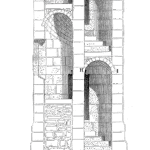
The Friedman test is a non-parametric test used to test for differences between groups when the dependent variable is at least ordinal (could be continuous). The Friedman test is the non-parametric alternative to the one-way ANOVA with repeated measures (or the complete block design and a special case of the Durbin test). If the data is significantly different than normally distributed this becomes the preferred test over using an ANOVA.
The test procedure ranks each row (block) together, then considers the values of ranks by columns. The data is organized in to a matrix with B rows (blocks) and T columns (treatments) with a single operation in each cell of the matrix. [Read more…]













